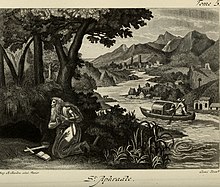Aphrahat
| St. Aphrahat the Persian Sage | |
|---|---|

Aphrahat depicted in Les Vies des Pères des déserts d'Orient : leur doctrine spirituelle et leur discipline monastique (1886)
|
|
| Born | c.280 |
| Died | c.345 |
| Honored in | Church of the East |
Aphrahat (c. 280–c. 345; Syriac: ܐܦܪܗܛ — Ap̄rahaṭ, Persian: فرهاد, Greek Ἀφραάτης, and Latin Aphraates) was a Syriac-Christian author of the third century from the Adiabene region of Assyria (then Sassanid ruled Assuristan), which was within the Persian Empire, who composed a series of twenty-three expositions or homilies on points of Christian doctrine and practice. All his known works, the Demonstrations, come from later on in his life. He was an ascetic and celibate, and was almost definitely a son of the covenant (an early Syriac form of communal monasticism). He may have been a bishop, and later Syriac tradition places him at the head of Mar Matti monastery near Mosul, in what is now northern Iraq. He was a near contemporary to the slightly younger Ephrem the Syrian, but the latter lived within the sphere of the Roman Empire. Called the Persian Sage (Syriac: ܚܟܝܡܐ ܦܪܣܝܐ, Ḥakkîmâ Pārsāyā), Aphrahat witnesses to the concerns of the early church beyond the eastern boundaries of the Roman Empire.
Aphrahat was born in Assuristan (Assyria) on the Sassanid Empire border with Roman Syria around 280. His name, Aphrahat, is the Syriac version of the Persian name Frahāt, which is the modern Persian Farhād (فرهاد). The author, who was known as hakkima pharsaya (Syriac for "the Persian sage"), was a subject of Sapor II and may have come from a pagan family and been himself a convert from heathenism, though this appears to be later speculation. However, he tells us that he took the Christian name Jacob at his baptism, and is so entitled in the colophon to a manuscript of 512 which contains twelve of his homilies. Hence he was already confused with Jacob, bishop of Nisibis, by the time of Gennadius of Marseilles (before 496), and the ancient Armenian version of nineteen of The Demonstrations has been published under this latter name. Thorough study of the Demonstrations makes identification with Jacob of Nisibis impossible. Aphrahat, being a Persian subject, cannot have lived at Nisibis, which became Persian only by Jovian's treaty of 363. Furthermore, Jacob of Nisibis, who attended the First Council of Nicaea, died in 338, and from the internal evidence of Aphrahat's works he must have witnessed the beginning of the persecution of Christians in the early 340s by Shapur II of Persia. The persecutions arose out of political tensions between Rome and Persia, particularly the declaration of Constantine I that Rome should be a Christian empire. Shapur perhaps grew anxious that the largely Assyrian and Armenian Christians within the Persian empire might secretly support Rome. There are elements in Aphrahat's writing that show great pastoral concern for his harried flock, caught in the midst of all this turmoil.
...
Wikipedia
